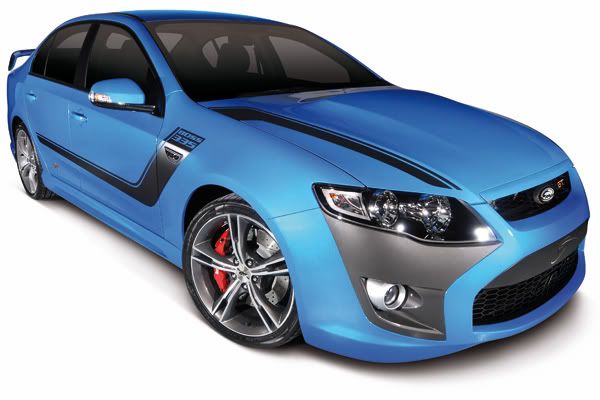Karn Evil
Active Member
I so wish Ford would bring this to the US.
http://news.pickuptrucks.com/2010/09/2011-ford-performance-vehicles-gs-boss-5-0-315-ute.html
We?re having Ute envy again.
Ford Performance Vehicles, Ford Australia's muscle car division, has created its latest high-performance Falcon car-based pickup that?s powered by an all-new factory-developed, supercharged version of Ford?s Boss (nee Coyote) 5.0-liter V-8.
The 5.0-liter Australian Boss V-8 differs from Ford Racing?s new dealer-installed supercharger kit for the 2011 Ford Mustang in the U.S., which features a Whipple blower and Roush intake but is attached to an otherwise standard 5.0 engine.
The FPV version shares some components with the Mustang's 5.0, but has added a range of high performance components to get the right balance between performance, efficiency and durability for a Ute application. It runs a unique supercharger that features sixth-generation U.S.-made Eaton twin-screw rotors with a displacement of 1.9-liters per revolution in an Australian-sourced Harrop intake housing.
A non-supercharged version of the 5.0 V-8 will be the heart of the 2011 Ford F-150 engine lineup.
The $32 million project, carried out by FPV's part owner Prodrive in conjunction with Ford, is expected to mean the GS Ute will be able to run from 0-60 mph well under the five second mark.
There will be two versions of the Boss V-8 for the Falcon: a base engine that pumps out 428 horsepower (315 kW, hence the Boss 315 name) and 402 pounds-feet of torque and a more potent unit that manages 456 hp and 421 pounds-feet.
Peak torque for both engines is available early and stays flat, from approximately 2,000 rpm all the way through 5,500 rpm, thanks to the blower.
Both engines will be available for the Falcon-based FPV sedan, while only the lower output engine will be fitted to the Ute.
FPV could well have the fastest production ute in Australia when the new model is introduced next month. It has only 3 hp less power and 4 pounds-feet less torque than GM?s Holden Special Vehicles Maloo ute but the Maloo runs a large displacement, naturally-aspirated 6.2-liter LS3 V-8.
Prodrive started work on the new engine three years ago under the working title Miami. There isn't any hidden meaning in the name, although a previous engine was called Las Vegas because the company felt it was taking a big risk developing it.
FPV previously sold a 5.4-liter V-8 that was based on the Ford F-Series? engine block combined with four-valve Mustang Cobra R heads and various locally sourced parts needed to develop the kind of performance required from an Australian muscle car. Strict Euro 4 emission laws meant that engine could no longer be produced after July 1 of this year.
FPV considered taking the naturally aspirated Coyote V-8 straight from the crate. It wasn't far off in terms of power but it didn't generate enough torque, hence the need for a supercharger. It ruled out using the supercharged AJ V-8 from Jaguar (which at the time was still part of the Ford family) due to high cost and packaging problems.
The Boss runs the standard 5.0 block and heads, but has unique cam timing and a different exhaust valve. There are stronger connecting rods, unique pistons, a cast stainless steel exhaust manifold (instead of fabricated steel), a different front end accessory drive, an engine oil cooler and a unique winged oil pan that holds 8.66 quarts of oil. It runs at a significantly lower compression ratio of 9.25-to-1 instead of 11-to-1.
Unlike any other Ford engine, the Boss 5.0 uses a free-flowing metal matrix catalytic converter which is normally only used by sports car makers such as Porsche and Ferrari.
FPV has set the boost pressure extremely low, at 5 psi for the base engine and 6 psi for the higher output version, leaving plenty of headroom to move up with subsequent model improvements.
The Boss Ute has an upgraded the six-speed ZF automatic transmission to cope with the extra torque or a newly refined version of Tremec?s six-speed manual.
The supercharged V-8 joins FPV's acclaimed turbocharged 4.0-liter F6 inline six-cylinder engine, which produces 422 hp and 417 pounds-feet and is available for both the Ute and sedan.
Ford has no plans to introduce the Australian Ute in the US and there?s a better than 50/50 that Ford?s global ?One Ford? vehicle platform-sharing policy could bring about its demise in 2015, when a new global large car is due to replace the Falcon.
At least the new supercharged 5.0 Boss 315 V-8 means that in the event the Ford Ute is retired, it will go out with a bang.
http://news.pickuptrucks.com/2010/09/2011-ford-performance-vehicles-gs-boss-5-0-315-ute.html












